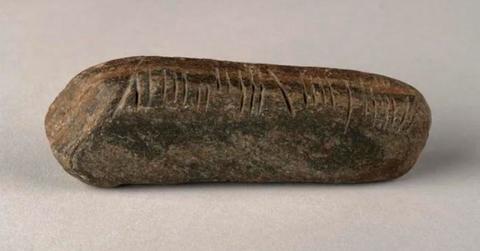Buried Treasure: 1,600-Year-Old Irish Script Found Etched on Stone in English Garden

The stone and its ancient inscription in the ogham alphabet were found in a garden in the English city of Coventry in 2020.
A English man weeding his garden unearthed a 1,600-year-old stone inscribed with a rare Irish alphabet.
Geography teacher Graham Senior discovered the stone while weeding a flower bed in his Coventry garden during the COVID lockdown. "It caught my eye as I was clearing an overgrown part of the garden," Senior said. "At first, I thought it was some kind of calendar."
Senior reported the find to the Portable Antiquities Scheme, and Teresa Gilmore, an archaeologist at the Birmingham Museums Trust, investigated the item.
Her efforts were fruitful when University of Glasgow historian Katherine Forsyth identified vertical lines etched into the stone as an inscription in early ogham — a script used to write early Irish from the fourth century and Old Irish between the sixth and ninth centuries. Forsyth visited Coventry to create a digital 3D model and translated part of the inscription as "Maldumcail/ S/ Lass," where "Mael Dumcail" is likely a person’s name, though the rest remains undeciphered.
The historic discovery, made in Coventry, central England, has left archaeologists puzzled about its origins.
Speculations about the stone’s presence in Coventry include the theories that it is a commemorative item, possibly brought by Irish Christian monks on a mission to convert the local pagan Mercians, or a tool used by an Irish tradesman to identify himself.
"There's a lot of possibilities as to why it came over," Gilmore explained to Live Science. "This is one of the things about some of the amazing finds that turn up — they often create more questions than answers."
- What Lies Beneath: NASA Scientist Believes Aliens May Have Found 'Perfect' Hiding Spot in Earth's Oceans
- Global Threat: Russia Insider Warns West of 'World War Using Nuclear Weapons' Amid Escalating Support for Ukraine
- Countdown to Disaster? Ex-NATO Official Warns Russia, Iran and China Could Wage WWIII in Just Years
The sandstone object weighs approximately 5 ounces and measures about 4 inches in length. The inscription is carved into three corners of the stone, a typical method before the advent of vellum, parchment and paper.
Never miss a story — sign up for the Front Page Detectives newsletter. Be on the scene the moment news breaks.
While similar to Norse runes, ogham consists of parallel lines grouped in sets of up to five and was developed independently for writing Irish. It was later replaced by the Insular script used throughout medieval Britain for Latin.
This stone is an uncommon find. Only around 400 ogham inscriptions are known to exist, with just ten discovered in England, according to Gilmore. Most ogham inscriptions are found in Ireland, with a few in Celtic regions of Britain like Wales, Scotland and Cornwall.
Senior has donated the stone to the Herbert Art Gallery and Museum in Coventry, where it will be displayed until April 2025. The museum also plans to conduct further research on the stone and its inscription.
"We might never know how Mael lost the stone and how it ended up in a garden in Coventry, but I hope future research will reveal more," Herbert museum curator Ali Wells said.
Become a Front Page Detective
Sign up to receive breaking
Front Page Detectives
news and exclusive investigations.
